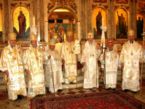Difference between revisions of "Deaconess"
m |
m (interwiki ro) |
||
| Line 51: | Line 51: | ||
[[Category:Church Life]] | [[Category:Church Life]] | ||
| + | |||
| + | [[ro:Diaconiţă]] | ||
Revision as of 21:35, January 23, 2011
| This article forms part of the series Clergy | |

| |
| Major orders | |
| Bishop - Priest - Deacon | |
| Minor orders | |
| Subdeacon - Reader Cantor - Acolyte | |
| Other orders | |
| Chorepiscopos - Exorcist Doorkeeper - Deaconess - Presbytide | |
| Episcopal titles | |
| Patriarch - Catholicos Archbishop - Metropolitan Auxiliary - Titular | |
| Priestly titles | |
| Archimandrite - Protopresbyter Archpriest - Protosyngellos Economos | |
| Diaconal titles | |
| Archdeacon - Protodeacon | |
| Minor titles | |
| Protopsaltes - Lampadarios | |
| Monastic titles | |
| Abbot - Igumen | |
| Related | |
| Ordination - Vestments Presbeia - Honorifics Clergy awards - Exarch Proistamenos - Vicar | |
| Edit this box | |
- This is an article about the order of deaconess. If you are looking for the wife of a deacon, see Diakonissa.
Deaconesses were an order in the primitive Christian Church. Information is sparse as to their activities at the time, though it is clear they were mostly involved with ministering to other women and girls.
It being improper for males to be physically handling women, deaconesses were commissioned to assist especially in baptism and chrismation.
It is an anachronism to say deaconesses did not perform the same liturgical role as deacons in the early church. That is imputing back in time to deacons a role which they were given considerably later in Church history.
In the early Church it is highly likely that deaconesses performed the same liturgical role as deacons, and quite likely more, because of the taboo on (male) priests touching female neophytes, or touching females requiring the sacrament of holy oil for the sick.
It is likely that the actual application of the holy oil onto the body of the women being chrismated was done by the deaconess, and not the priest. The priest did the praying and supervised, but did not touch. Deacons would not have performed this role. As there was no taboo on the priest physically applying the oil to male candidates, there was no need for deacons to be involved in this.
The Japanese Orthodox Church from its inception in the later half of the nineteenth century had some deaconesses. Japan's first bishop, St. Nicholas Kasatkin, had a number of deaconesses during his tenure.
At the same time, the Russian Orthodox Church, Japan's mother Church, had deaconesses. It seems from the scant material available that the Russian Church has always had deaconesses.
The Church of Greece has had deaconesses intermittently over the recent centuries, and appears to have usually had deaconesses in its female monasteries from time immemorial. In 2004 the Holy Synod of the Church of Greece officially restored the female diaconate.[1]
The Russian Orthodox Church still has deaconesses.[2]
In female monasteries the role of a deaconess seems necessary for the good order and function of the monastery church. It is more seemly than having male deacons involved there.
In 2006, the larger Bulgarian and Romanian monasteries have a deaconess who is usually second in charge. In Romania they wear distinctive garb while performing diaconal duties.
The question of having deaconesses perform the liturgical role of deacons in parish churches or cathedrals could be seen as a different matter since the practice of having deaconesses assist in those places seems to have generally died out in the Byzantine Church about 600 years ago with the inception of the Ottoman yoke.
Contents
Source
References
- ↑ "Grant Her Your Spirit" by Phyllis Zagano, America: The National Catholic Weekly, February 7, 2005.
- ↑ "Deaconesses" which points to Item 8 of The minutes of the meeting of the Holy Synod of the Russian Orthodox Church, April 11, 2006 as evidence for the existence of deaconesses in the Russian Church.
See also
External links
- "Order for the Ordination of a Woman Deacon"
- "Ordination of a Woman Deacon" offers background to the link above, both from the Euchologion of the Monastery of Saint Andrew the First Called in Manchester, England
- The Historical Orthodox Deaconess
- Archive of "Female Deacons in the Byzantine Church" by Valerie Karras
- Archive of "The Liturgical Functions of Consecrated Women in the Byzantine Church" by Valerie Karras
- "Prayers for the Ordination of Women Deacons as found in Georgian Manuscripts", taken from: "The Georgian Version of the Liturgy of St. James," F. C. Conybeare and Oliver Wardrop, from Revue de l'Orient Chretien, XIX, 1914 (Paris)
- Book Review: Women Deacons in the Orthodox Church: Called to Holiness and Ministry by Kyriaki Karidoyanes FitzGerald, reviewed by Deborah Malacky Belonick for St. Nina's Quarterly
- "An Interview with Kyriaki Karidoyanes FitzGerald" by Teva Regule of the St. Nina's Quarterly
- Church of Greece Restores Diaconate for Women by Dr. Kyriaki Karidoyanes FitzGerald
- Toward a Complete Expression of the Diaconate: Discerning the Ministry Women Deacons (PDF) by Kyriaki Karidoyanes FitzGerald, M.Div., Ph.D.